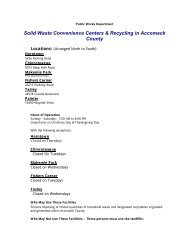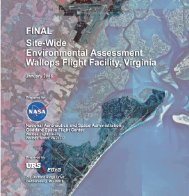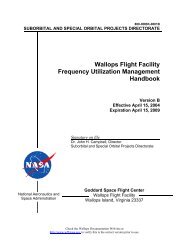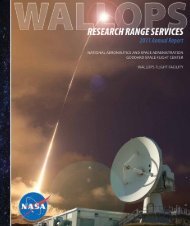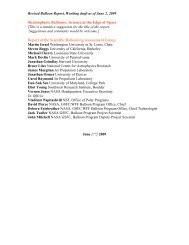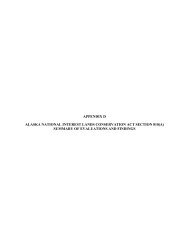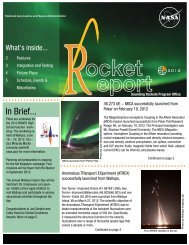Alternative Energy Draft EA - NASA Visitor Center at Wallops Flight ...
Alternative Energy Draft EA - NASA Visitor Center at Wallops Flight ...
Alternative Energy Draft EA - NASA Visitor Center at Wallops Flight ...
Create successful ePaper yourself
Turn your PDF publications into a flip-book with our unique Google optimized e-Paper software.
Proposed Action and <strong>Altern<strong>at</strong>ive</strong>s<br />
The workspace radius required around each turbine tower during construction activities would be<br />
approxim<strong>at</strong>ely 45.7 meters (150 feet). Clearing of existing veget<strong>at</strong>ion beyond the found<strong>at</strong>ion and<br />
crane pad footprints would not be required. A crane pad would be installed within the 45.7-meter<br />
(150-foot) radius of the wind turbine and would be approxim<strong>at</strong>ely 15.2 meters (50 feet) by 15.2<br />
meters (50 feet). The orient<strong>at</strong>ion and size of the crane pad could vary depending on the<br />
requirements of the wind turbine construction contractor.<br />
Underground power collection lines would be built to interconnect each wind turbine to the<br />
existing <strong>Wallops</strong> Island 12.47-kilovolt electrical distribution system (see Figure 6). These power<br />
lines would be installed in conduit via horizontal directional drilling, which is a trenchless<br />
method of installing underground pipes, conduits, and cables in a shallow arc along a prescribed<br />
bore p<strong>at</strong>h, to minimize wetland disturbance. Step-up transformers for each wind turbine would<br />
be air-insul<strong>at</strong>ed and installed inside the base of the each tower. Additionally, interconnection<br />
switchgear would be installed inside the tower assemblies. All electrical equipment would be<br />
installed inside and out of the we<strong>at</strong>her to minimize potential corrosion on the equipment and<br />
potential wetland disturbance.<br />
2.3.1.2 Residential-Scale Turbines<br />
Up to five residential-scale (2.4 kW) wind turbines would be installed under the Proposed<br />
Action. The represent<strong>at</strong>ive residential-scale wind turbine described in Section 2.1.1.1 and Table<br />
4 would be used. One of the 2.4 kW wind turbines would be installed near the WFF <strong>Visitor</strong><br />
<strong>Center</strong>, and a second would be installed near the security guard st<strong>at</strong>ion <strong>at</strong> the Mainland (Figure<br />
4). The loc<strong>at</strong>ions of the remaining three wind turbines are unknown <strong>at</strong> this time, but would be<br />
placed within the areas th<strong>at</strong> <strong>NASA</strong> has identified as potential suitable loc<strong>at</strong>ions <strong>at</strong> WFF (see<br />
Section 2.1.1.2 for a description of the methodology used to determine potentially suitable<br />
loc<strong>at</strong>ions). Figure 4 shows the potentially suitable areas where three of the 2.4 kW wind turbines<br />
could be installed.<br />
The wind turbines would be constructed with a setback distance of 30 meters (100 feet) from<br />
existing towers, buildings, and trees. The finished subsurface footprint of each 2.4 kW wind<br />
turbine would be approxim<strong>at</strong>ely 1 meter (3 feet) in diameter, with a found<strong>at</strong>ion depth of 6 meters<br />
(20 feet). No transformers or interconnection switchgear would be needed. Standard home<br />
electric wiring (10 gauge) would be buried in a trench from the wind turbine to the desired<br />
facility.<br />
2.3.1.3 Oper<strong>at</strong>ion, Maintenance, and Decommissioning<br />
Oper<strong>at</strong>ion and Maintenance<br />
<strong>NASA</strong> would utilize d<strong>at</strong>a currently collected <strong>at</strong> various loc<strong>at</strong>ions/towers on <strong>Wallops</strong> Island to<br />
monitor wind speed and direction, r<strong>at</strong>her than building a new meteorological tower specifically<br />
for the Proposed Action. Existing WFF maintenance staff along with on-call manufacturer<br />
maintenance support staff would be used to maintain the turbines and transmission system; no<br />
new staff would be hired for the oper<strong>at</strong>ion and maintenance of the turbines. Oper<strong>at</strong>ions and<br />
maintenance staff and equipment would be housed in existing <strong>NASA</strong> facilities, neg<strong>at</strong>ing the need<br />
to construct any new buildings for oper<strong>at</strong>ions and maintenance.<br />
22




